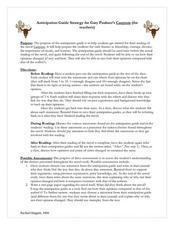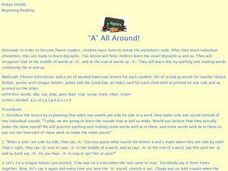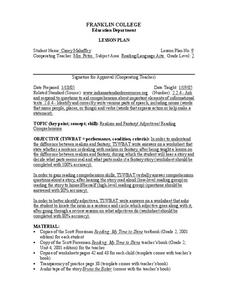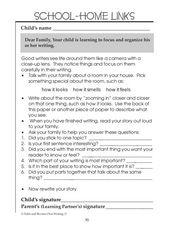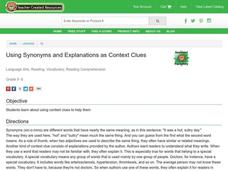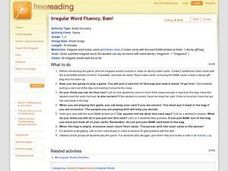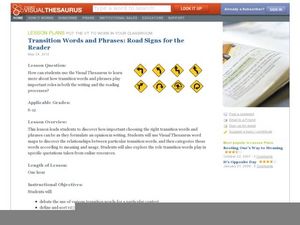Curated OER
Reintroduce /c/
Do you c what I c? Use these strategies combining pronunciation, letter recognition, and initial phoneme examples to examine the letter c with kindergartners. Scholars examine the letter shape and listen to you pronounce the soft /c/...
Curated OER
Anticipation Guide Strategy for Gary Paulsen's Canyons (For Teachers)
"Things never change." "It's okay to steal from those who already have a lot." Before reading Canyons, readers respond to an anticipation guide that focuses on issues raised in Gary Paulsen's novel. Groups share their responses, and...
Curated OER
"More Than One"
Help your class learn the spelling rule for adding -es to plural nouns and third-person singular verbs. The resource suggests using songs daily to reinforce the rules. The songs are contained in a Sing Your Way Through Phonics 2-CD set...
Curated OER
"A" All Around
Spell and read words containing ai and ay. First and second graders identify vowel digraphs in written and spoken language. After a brief discussion on the combinations of letters that comprise digraphs, they practice reading and...
Curated OER
Realism and Fantasy
Second graders listen to the story, Bruno the Baker, where some parts seem real and some seem fake. They must identify the parts of the story as realism or fantasy. An interesting way to teach young readers these two concepts.
Curated OER
Sound It Out!
Help your class improve their spelling skills. Learners take a test, are given a particular spelling rule to practice, and play a Bingo game. This employs various methods for practicing spelling skills.
Curated OER
Presentations Come Alive!
Partners create oral presentations about a short story or poem incorporating audiovisual aids. Then they make presentations to their classmates. Linked story map will help guide readers' organization of their presentation;...
Curated OER
Hop on the Express Train to Read Expressively
Encourage beginning readers to read expressively. After the teacher models what it's like to read with expression, pairs of learners work together to practice developing this ability. While one learner reads, the other marks a check-list...
Curated OER
Iggy the Penguin
Take your young word detectives on a hunt for the /i/ sound. Use the tongue twister about Iggy the penguin to help learners identify the target sound. Then learners are given several words, and they have to use their detective skills to...
Curated OER
On The Day You Were Born
Students engage in a study about the holiday of a birthday with the help of using children's literature. They make cognitive connections of using the characters of the book and relating them to the personal celebration of a birthday.
Curated OER
Sonnet Worksheet
Are your middle schoolers writing a sonnet? Here's a worksheet to help them craft their first sonnet! Make edits as you see necessary.
Curated OER
Walk Two Moons: Chapter 11
In this Walk Two Moons comprehension check worksheet, pupils respond to 12 short answer questions covering chapter 11 of Walk Two Moons by Sharon Creech in order to help them better understand the chapter and the novel.
Curated OER
8 Comma Rules
In this comma rules activity, students read 30 sentences and add commas where needed. Detailed rules for the use of commas are on the page to help.
Curated OER
Learning to Organize Writing
Encourage focus and organization in the writing of your second, third, and fourth grade classes. Learners are asked to select a room in their house and narrow in on how it looks, smells, or feels. After writing a short paragraph...
Curated OER
Using Synonyms and Explanations as Context Clues
How can context clues help your young readers understand material better? Focusing on synonyms and explanations as ways to determine word meaning, this activity encourages your class to find context clues within a sentence. An attached...
Curated OER
Practice With Multiple-Meaning Words
Second graders work with multiple meaning words. They participate in a teacher led lesson about words with have more than one meaning. Everyone completes a skill building worksheet in which sentences using words with more than one...
Curated OER
Documentary-Style Research Projects
Show your pupils how to use guiding questions to help them focus their research into a topic. Using the framework provided by these questions, researchers explore a topic, collect interesting facts, and prepare a PowerPoint presentation...
Curated OER
Sea to Sky Adjectives Booklet
Adjectives build better sentences! First, second, third, and fourth graders design adjective booklets that feature words to describe everything between the sea and the sky.
Curated OER
Capitalization and Punctuation
First and second graders explore writing conventions. They add question marks or periods to the end of teacher generated sentences on sentence strips. They locate punctuation marks in poems and write original sentences using appropriate...
Curated OER
Adventures of Huckleberry Finn: Pass the Huck Quiz
In this online, interactive quiz, your test taker has one minute and twenty seconds to complete seven multiple choice questions surrounding reading comprehension. Note: the computer effects are very distracting (which interferes with the...
Curated OER
Irregular Word Fluency, Bam!
Build word fluency! With this word recognition lesson, first and second graders play a game to practice saying irregular words with automaticity. They play in small groups using a set of word cards provided by their teacher. This lesson...
Curated OER
Transitions
Give examples of transitions and why they are necessary in writing. A bit verbose, this handout is very thorough and provides many examples. The second page lists plenty of transitional phrases in a convenient chart.
San José State University
Dangling Modifiers
You don't want to leave your modifier dangling! Using this worksheet, you can help students on their way to understanding how to modify sentences and to eliminate dangling modifiers.
Curated OER
Transition Words and Phrases: Road Signs for the Reader
Therefore! However! Furthermore! Explore the power of transition words and phrases. Signal your readers by suggesting the relationship between different thoughts or points. Help them demonstrate an understanding of word relationships.



